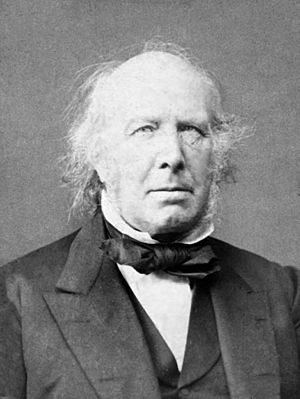William Sharpey facts for kids
Quick facts for kids
William Sharpey
|
|
|---|---|
 |
|
| Born | 1 April 1802 Arbroath, Scotland
|
| Died | 11 April 1880 |
William Sharpey (born April 1, 1802 – died April 11, 1880) was a very important Scottish scientist. He studied the human body, focusing on its structure (called anatomy) and how it works (called physiology). Many people call him the "father of British physiology" because he was so good at studying how living things function. He was a pioneer in experimental biology, meaning he used experiments to learn about life.
Contents
William Sharpey's Early Life
William Sharpey was born in Arbroath, Scotland, on April 1, 1802. He was the youngest of five children. Sadly, his father, Henry Sharpy, passed away before William was born.
William went to high school in Arbroath. In November 1817, he started studying at the University of Edinburgh. He first learned about humanities and natural philosophy, which included science. In 1818, he switched to medical classes. He learned anatomy from Professor John Barclay, a well-known teacher at the time.
Becoming a Doctor
In 1821, Sharpey earned his first medical degrees (MB ChB). He then became a member of the Edinburgh College of Surgeons. To learn even more, he traveled to London and then to Paris. In Paris, he spent almost a year learning about surgery from famous doctors like Guillaume Dupuytren. He also met James Syme, another important surgeon, and they stayed friends for many years.
In August 1823, Sharpey received his doctorate (MD) from the University of Edinburgh. He then returned to Paris for most of 1824. After that, he lived in Arbroath for a while, working with his stepfather, Dr. Arrott. But William loved to learn and explore!
He went on a long walking trip through Europe. He walked through France to Switzerland and then to Italy. In 1828, he studied in Padua and then spent nine months in Berlin. He also studied in Heidelberg and Vienna, learning from top scientists in different countries.
Sharpey's Academic Career
Sharpey returned to Edinburgh in 1829. In 1830, he became a fellow of the College of Surgeons of Edinburgh. This allowed him to become a teacher. In 1831, he spent three more months studying in Berlin.
From 1831 to 1832, he taught anatomy with Allen Thomson in Edinburgh. They gave some of the first full courses on systematic anatomy. In 1834, he was chosen as a fellow of the Royal Society of Edinburgh, a very respected group of scientists.
Professor in London
In July 1836, Sharpey was given a big job: he became the professor of anatomy and physiology at the University of London. He was the first to teach a complete course on physiology and tiny anatomy (microscopic anatomy) there. He taught these classes for an amazing 38 years!
Sharpey also became an examiner in anatomy at the University of London in 1840. He was also a member of the university's senate, which helped make important decisions. In 1839, he was elected a Fellow of the Royal Society, another very important scientific group.
Discoveries and Influence
In 1846, Sharpey described special fibers in our bones that help connect bone to tendons. These fibers are now named after him: Sharpey's fibres. He became a secretary of the Royal Society in 1853 and held that job until he retired. He also helped oversee medical education in Britain for 15 years.
In 1859, the University of Edinburgh gave him an honorary doctorate (LLD) for his important writings. Many famous scientists, like Michael Foster and George Oliver, were his students. Sharpey was also friends with Charles Darwin, the famous naturalist. He was also involved in a commission about scientific education and was a fellow of the Geological Society.
Later Life and Legacy
Around 1871, Sharpey's eyesight started to fail. He retired from his job as secretary of the Royal Society. In 1874, he also retired from his professorship at University College. The government gave him a pension for his long service.
William Sharpey passed away from bronchitis on April 11, 1880, in London. He was buried with his parents in the graveyard of Arbroath Abbey in Scotland.
Family Connections
William Sharpey was the half-brother of James Arrott. James Arrott became the head physician at the Dundee Royal Infirmary.
Things Named After Him
- Sharpey's fibres—These are special fibers that connect the layers of bone and help anchor bone to tendons. William Sharpey described them in 1846.
Images for kids




